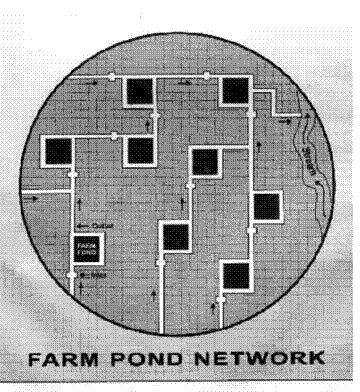The first project was conducted by the BAIF Development Research Foundation in the Hassan District of Karnataka. They created a linked network of 350 farm ponds covering 700 hectares of the watershed. All of the ponds were 3 meters deep and between 6 and 9 meters in length and width. They were connected through trapezoid shaped trenches lined with bunds, which were graded to minimize the scouring velocity of flowing water. Along the bunds they planted mango, cashew, coconut, and tamarind trees. They also built check-dams across some small gullies and tanks across some larger drainages. They found that the farm ponds were functioning as percolation pits in that they remained full for only 15 days after rainfall. However, in the lower portions of the watershed, after several years the water table began to rise and the ponds remained full year round. Several wells that had been dry started to yield water throughout the year. The project was successful in recharging groundwater, and providing temporary localized water supply even in the uplands. However, long-term water supply in the uplands will depend on redistribution of the water from the lowland recharge areas into the upland discharge areas.
 The second project was organized in the Chotanagpur plateau in North Orissa. The watershed was divided into uplands, midlands, and lowlands, and each region received a different treatment. In uplands with greater than 8% slope, staggered trenching was used. Less sloping uplands were bunded into rectangular plots 9m by 12m. This method is called tie-ridging, and is used to slow the movement of rainwater and soil off of the landscape. In the lower corner of each plot, 2m by 2m by 1m deep pits were dug for percolation. The soil removed from these pits was used to make the bunds 0.3 meters wide and 0.2 meters high, which were planted with trees, shrubs, and grasses. Meanwhile, the land inside the squares was sown with pulses, oil seeds, millets, and vegetables like pumpkin, tomato, and brinjal.
The second project was organized in the Chotanagpur plateau in North Orissa. The watershed was divided into uplands, midlands, and lowlands, and each region received a different treatment. In uplands with greater than 8% slope, staggered trenching was used. Less sloping uplands were bunded into rectangular plots 9m by 12m. This method is called tie-ridging, and is used to slow the movement of rainwater and soil off of the landscape. In the lower corner of each plot, 2m by 2m by 1m deep pits were dug for percolation. The soil removed from these pits was used to make the bunds 0.3 meters wide and 0.2 meters high, which were planted with trees, shrubs, and grasses. Meanwhile, the land inside the squares was sown with pulses, oil seeds, millets, and vegetables like pumpkin, tomato, and brinjal.
In the midlands, plots for rice were laid out approximately 33m meter to a side, surrounded by bunds, with small farm ponds excavated in the lowest corner (using 5% of the land). In the lowlands, larger ponds were built. The picture shows how the watershed was divided into regions. Trees, grasses, and shrubs used were: Sisoo (Dalbergia sisoo), Gamhar (Gmelina arborea), Sabai (Eulaliopsis binata), Dinanath (Penissetum pedicelletum), and Pigeonpea (Cajanus cajari).
